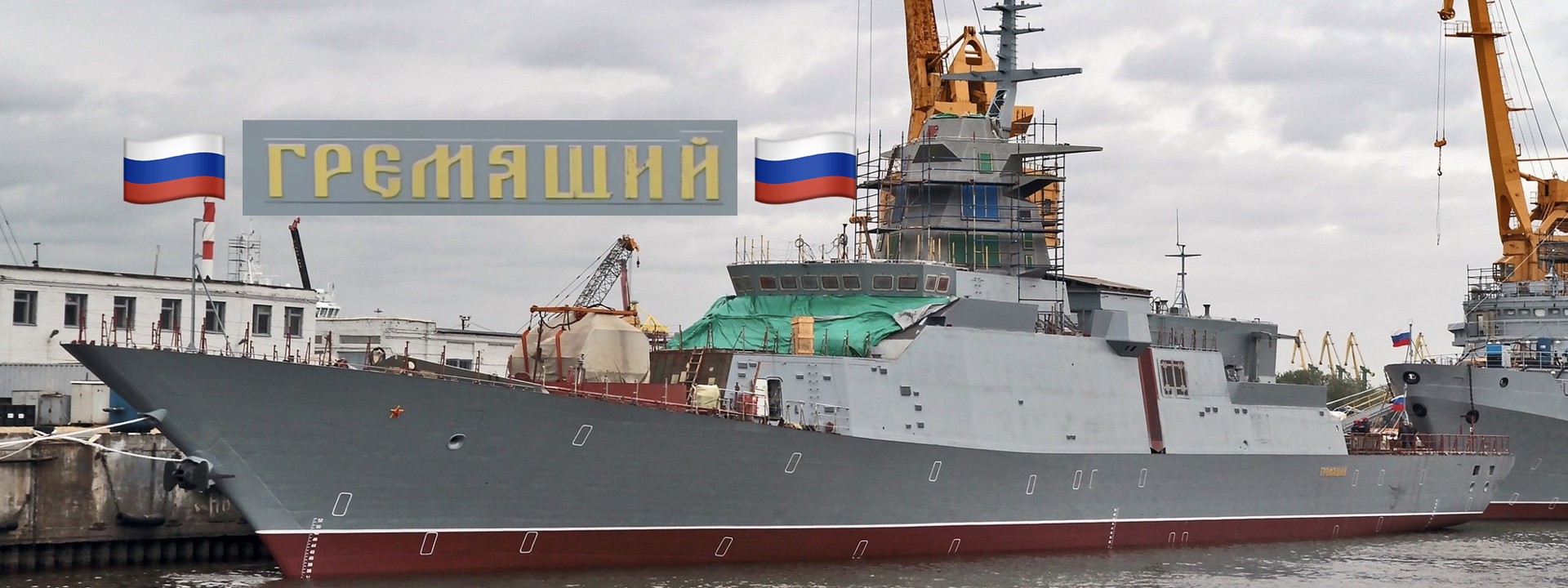#PutinAtWar: Latest Additions to the Russian Navy
A brief look into new warships reportedly joining the Russian Navy in 2018
#PutinAtWar: Latest Additions to the Russian Navy

A brief look into new warships reportedly joining the Russian Navy in 2018

Russia’s new Naval Doctrine might sound unrealistic, but the Russian Navy is pushing hard to reach their goals. The navy doctrine introduced in July 2017 declared the goal to build a strong fleet that will allow Russia to occupy the leading positions in the world until 2030. @DFRLab previously reported on Russia’s recent nuclear submarine developments. This time we are taking a look into Russia’s new warships scheduled to join the fleet in 2018.
On November 30, first video footage surfaced on the internet providing a glimpse into the newest additions to the fleet. TV Zvezda released a video report, in which three new ships were introduced: The first corvette Gremyaschy (Гремящий) of the project 20385 (NATO reporting name: Steregushchy-class), the second vessel Ivan Khurs (Иван Хурс) of the project 18280 (NATO reporting name: Yuriy Ivanov-class), and the second frigate Admiral Kasatonov (Адмирал флота Касатонов) of the project 22350 (NATO reporting name: Gorshkov-class).
30.11.17 footage of the 1st Pr.20385 #corvette Gremyashchiy at the Severnaya Verf shipyard, #Russia. Also note 2nd Pr.18280 Ivan Khurs, 2nd Pr.22350 Admiral Kasatonov and others. ©TV Zvezda pic.twitter.com/WWEasfoKLg
— S O V A (@Russian_Defence) December 4, 2017
September 23 satellite imagery from GoogleMaps captured these ships docked in the Bol’Shoy Basseyn area of Severnaya Verf shipyard.

Corvette Gremyaschy
Gremyashchy is the first corvette of project the 20385; the second warship of the series — the Provorny — is in the early stages of the construction. These multi-role corvettes were designed to detect and destroy adversary submarines and surface warships, to conduct landing operations, and other various missions. The warship is armed with the 3K96 Redut anti-aircraft system, and the Paket-E/NK antisubmarine warfare system, as well as boasts a hangar for Ka-27 (NATO reporting name Helix) helicopter. Most importantly, the ship is armed with universal nuclear-capable Kalibr missile systems, which are currently being used in Russia’s military operations in Syria.
The corvette was first launched into the water on June 30, 2017. According to the video report, the current technical readiness of the ship is 65 percent. Gremyashchy is expected to be handed to the Russian Navy by the end of 2018.

Frigate Admiral Kasatonov
Admiral Kasatonov is the second frigate of project 22350 and the largest surface warship built by Russia since the collapse of the Soviet Union. Admiral Kasatonov is a multi-purpose platform designed for anti-air, anti-surface, and anti-submarine warfare operations. The ship is armed with the P-800 Oniks (NATO reporting name SS-N-26 Strobile) anti-ship missile and — like the Gremyashchy — Admiral Kasatonov is armed with nuclear-capable Kalibr missiles, able to hit land, sea, and underwater targets.
The Russian Navy reportedly plans to build three additional ships of the Admiral Gorshkov-class. Admiral Kasatanov will reportedly be handed over to the Russian Navy in February 2018.

Frigate Ivan Khurs
Ivan Khurs is the second frigate of project 18280 and is the largest Russian vessel of this class. The vessel is designed to provide communication and control for fleet forces, conduct electronic warfare, radio, and electronic intelligence. The most important function is reportedly to penetrate the United States’ missile defense system (AEGIS) and provide the possibility for Russian missiles to defeat potential adversary defenses, target, and destroy.
Ivan Khurs was launched first in May 2017 and currently the technical readiness of the vessel is 99 percent. It is expected to join the Northern fleet in 2018.

Conclusion
Newly introduced Russian naval doctrine appears to promote a vision of a revived Russian Navy that can maintain its superiority over smaller international maritime actors and pose a serious threat to the U.S. Navy in certain environments. Development of new modern warships and nuclear submarines, coupled with the prevalent use of naval force and support in the Syrian conflict signify Russia is taking the new doctrine seriously. Russia has also recently expanded its naval presence by signing a treaty with Syria to accommodate more ships in the Tartus naval base.
@DFRLab will continue to monitor Russia’s military developments and exercises.
Follow along for more in-depth analysis from our #DigitalSherlocks.

